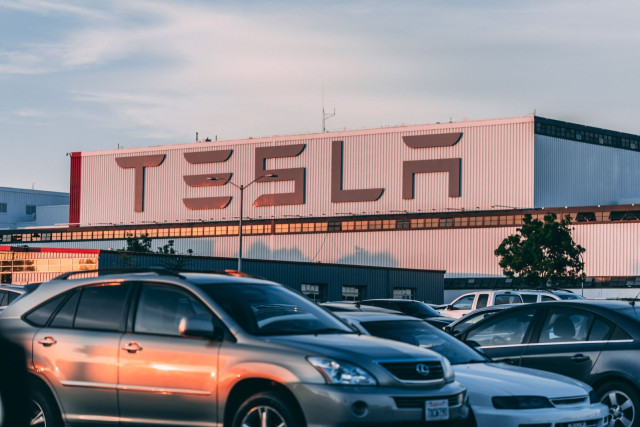Tesla's Quarterly Performance Falls Short of Expectations, but Production Target Remains Intact
- Posted on October 19, 2023
- Business
- By Arijit Dutta
- 508 Views
In a recent report, Tesla, the electric car giant, faced disappointment as it missed margin estimates during the third quarter. Despite aggressive price cuts, Tesla's quarterly gross margin plummeted to a more-than four-year low. However, the company remained steadfast in its commitment to achieving its annual production target, indicating that it is still generating substantial demand in the electric vehicle market.
 Image Source -www.nasdaq.com
Image Source -www.nasdaq.com
In a recent report, Tesla, the electric car giant, faced
disappointment as it missed margin estimates during the third quarter. Despite
aggressive price cuts, Tesla's quarterly gross margin plummeted to a more-than
four-year low. However, the company remained steadfast in its commitment to
achieving its annual production target, indicating that it is still generating
substantial demand in the electric vehicle market.
During the third quarter, Tesla's revenue, profit, and
gross margin all fell short of analysts' expectations. In response, the company
announced its intention to continue reducing production costs in order to boost
profitability. Tesla has been embroiled in a price war since the beginning of
the year, an initiative aimed at capturing a larger share of the electric car market, even in the face of high-interest rates and stiff competition from rival
automakers.
To attain its ambitious annual production goal of 1.8
million vehicles, some analysts believe Tesla may need to further reduce its
prices. In a statement, the company acknowledged the need to be a cost leader
within the industry. Tesla's gross margin for the quarter ending in September
dropped to 17.9%, a significant decline from 25.1% a year earlier before the
price cuts began. This margin was also below the 18.2% gross margin recorded in
the previous quarter.
Gary Bradshaw, a portfolio manager at Hodges Capital
Management, remarked that while further price cuts might be necessary given the
challenges posed by higher interest rates, Tesla appears to be approaching a
critical point in terms of profit margins.
Wall Street had initially anticipated Tesla to post a
margin of 18.02%, based on a poll of 21 analysts conducted by Visible Alpha. On
average, 17 analysts polled by LSEG data expected a margin of 18.25%. Notably,
the automotive gross margin, excluding regulatory credits, fell to 16.3% during
the third quarter, down from 18.1% in the previous quarter, despite a reduction
of around $2,000 per vehicle in raw material costs.
Tesla attributed the margin decline to the
underutilization of new factories and an increase in operating expenses, primarily
due to the forthcoming Cybertruck model and investments in artificial
intelligence and other projects.
Despite the challenging financial results, Tesla's shares
displayed volatility during extended trading, ranging from a 1% increase to a
2% decrease, following a 4.8% drop in closing. The company's stock had more
than doubled in value during the year, as investors remained optimistic about
its long-term margin prospects, driven by self-driving software.
Additionally, Tesla announced that it had commenced pilot
production of the Cybertruck at its Texas Gigafactory, with the first
deliveries scheduled for November 30. However, Elon Musk, Tesla's CEO,
cautioned that there would be "enormous challenges" in achieving
volume production for the Cybertruck while maintaining positive cash flow. Musk
suggested that it might take a year to 18 months before the Cybertruck becomes
a significant positive cash flow contributor.
The Cybertruck, which has been delayed multiple times, is poised to compete with vehicles such as Rivian's R1T, Ford's F-150 Lightning, and General Motors' Chevrolet Silverado in the booming pickup truck market.
Also Read: Afghanistan's Fielding Woes Cost Them Victory Against Unbeaten New Zealand In ICC Cricket World Cup
In terms of financial performance, Tesla reported
third-quarter revenue of $23.35 billion, a 9% increase. However, this fell
short of analysts' estimates, which had predicted revenue of $24.1 billion.
This marked the slowest pace of revenue growth in over three years. Notably,
the average revenue per unit declined by nearly 11% from the previous year.
On an adjusted basis, Tesla earned 66 cents per share,
falling short of analysts' expectations of 73 cents per share, as reported by
LSEG data. It remains uncertain whether the numbers were directly comparable.
Tesla also highlighted the growing significance of its energy business, which includes the sale of solar panels and batteries, as well as its services business. These segments collectively contributed more than $500 million in gross profit during the quarter, underscoring the company's diversification beyond electric vehicles.




